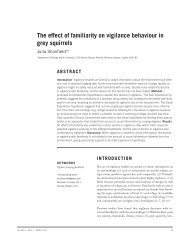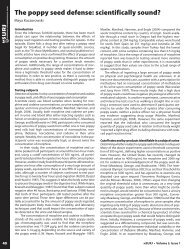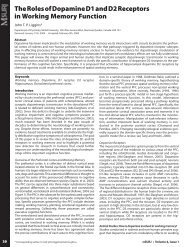the entire issue - McGill Science Undergraduate Research Journal ...
the entire issue - McGill Science Undergraduate Research Journal ...
the entire issue - McGill Science Undergraduate Research Journal ...
Create successful ePaper yourself
Turn your PDF publications into a flip-book with our unique Google optimized e-Paper software.
Stress reactivity during evaluation by <strong>the</strong> opposite sex: comparison of responses induced by different psychosocial stress tests<br />
Discussions<br />
Opposite Sex Effects<br />
Our main objective in this project was to determine whe<strong>the</strong>r opposite-sex<br />
testing significantly affected <strong>the</strong> stress responses of participants<br />
in a differential manner depending on <strong>the</strong>ir sex. Overall,<br />
opposite-sex testing did not seem to affect men and women in a differential<br />
manner. Apart from <strong>the</strong> subjective stress difference in <strong>the</strong><br />
TSST (women rated higher in subjective stress) and <strong>the</strong> systolic BP<br />
difference in <strong>the</strong> MAST (men showed a greater systolic BP response),<br />
participants did not significantly differ in overall stress response.<br />
It is possible that <strong>the</strong> TSST produced a greater subjective stress response,<br />
being more sensitive to opposite sex evaluation due to its<br />
“job interview”-like, public speech context, period of preparation,<br />
and long speech time in front of an opposite-sex panel. Fur<strong>the</strong>rmore,<br />
it is likely that women in <strong>the</strong> follicular phase of <strong>the</strong>ir menstrual cycle<br />
are more susceptible to feeling stressed in this situation due to <strong>the</strong>ir<br />
heightened sensitivity to male stimuli (6).<br />
Tests<br />
In this project, we compared physiological and subjective responses<br />
to <strong>the</strong> TSST, <strong>the</strong> CPT, and <strong>the</strong> MAST stress tests when <strong>the</strong> tests were<br />
administered by experimenters of <strong>the</strong> opposite sex. Since <strong>the</strong> MAST<br />
is a newly developed stress task, this project was <strong>the</strong> first to both<br />
include women and directly compare its efficacy to that of <strong>the</strong> TSST<br />
and <strong>the</strong> CPT when administered by opposite-sex experimenters. In<br />
all tests, exposure produced a main effect of time in all repeated<br />
measures (cortisol, systolic and diastolic blood pressure, heart rate<br />
and subjective stress) indicating that all three stress tests were successful<br />
in producing significant responses in participants.<br />
Our main hypo<strong>the</strong>sis for this project was that <strong>the</strong> MAST administered<br />
by experimenters of <strong>the</strong> opposite sex would induce a comparable cortisol<br />
response to <strong>the</strong> TSST, and that both would generate higher responses<br />
than <strong>the</strong> CPT. Analyses of overall cortisol levels suggest that<br />
<strong>the</strong> CPT produced a significantly lower cortisol response than <strong>the</strong><br />
TSST. The cortisol levels induced by <strong>the</strong> MAST were not significantly<br />
different from those induced by <strong>the</strong> TSST. In addition, a significant<br />
cortisol time by test effect was observed within subjects, where TSST<br />
and MAST cortisol values closely mirrored each o<strong>the</strong>r and CPT values<br />
were significantly lower. Subjects’ cortisol responses over time<br />
were increasing following TSST, MAST and CPT. Therefore, at least in<br />
terms of HPA axis activation as indicated by salivary cortisol levels<br />
(and thus <strong>the</strong> effectiveness of a stress test to induce a stress at a psychosocial<br />
level), TSST and MAST seem to be equally effective.<br />
Although blood pressure did not differ as a result of exposure to any<br />
of <strong>the</strong> tests, each test elicited different heart rate variations in participants<br />
over time. This suggests that both <strong>the</strong> MAST and <strong>the</strong> TSST<br />
are effective in producing an autonomic response in heart rate and<br />
that <strong>the</strong>y are also both better at eliciting this response than <strong>the</strong> CPT.<br />
Therefore, it seems that stress induction tests with a psychosocial<br />
quality are not only better at activating <strong>the</strong> HPA axis, but also at producing<br />
an increased autonomic heart rate response.<br />
When <strong>the</strong> participants of <strong>the</strong> CPT were divided into “high” and “low”<br />
self-esteem groups, <strong>the</strong>re was a significant change in participants’<br />
subjective stress ratings over time. This change varied between tests.<br />
Each test thus elicited a significantly different subjective stress response<br />
within each participant throughout <strong>the</strong> testing period. Significant<br />
test effects between subjects also showed that <strong>the</strong> TSST, <strong>the</strong><br />
MAST, and <strong>the</strong> CPT low-self-esteem groups all produced significantly<br />
greater subjective stress ratings than <strong>the</strong> CPT high-self-esteem<br />
group. This could perhaps be because individuals with very high<br />
self-esteem tend to be markedly more confident in <strong>the</strong>ir ability to<br />
cope with stressors and <strong>the</strong>refore perceive less stress throughout <strong>the</strong><br />
procedure. The opposite would <strong>the</strong>n be true for those with low selfesteem<br />
(i.e. less confidence) (5). In o<strong>the</strong>r words, self-esteem seems to<br />
buffer <strong>the</strong> subjective perception of stress during stress exposure in<br />
high-self-esteem individuals (5).<br />
The results obtained from <strong>the</strong> MAST alone demonstrate that it causes<br />
a significant change in activation of both <strong>the</strong> HPA and SAM axes<br />
as well as in subjective stress over time in each participant. This is<br />
shown by a significant time effect within participants in cortisol levels,<br />
systolic and diastolic blood pressure, and heart rate measures<br />
as well as subjective stress ratings, in that all increase subsequently<br />
to task onset. These results fur<strong>the</strong>r confirmed those of Smeets et al.<br />
(2012) as well as our hypo<strong>the</strong>sis that <strong>the</strong> MAST would be an effective<br />
stress induction test that could significantly activate both <strong>the</strong> HPA<br />
and <strong>the</strong> SAM axes. Its ability to do so is possibly related to <strong>the</strong> fact<br />
that <strong>the</strong> MAST contains aspects of both psychosocial and physical<br />
stressors.<br />
When compared to <strong>the</strong> o<strong>the</strong>r tests, our findings clearly demonstrate<br />
that <strong>the</strong> MAST is comparable to <strong>the</strong> effectiveness of <strong>the</strong> TSST. Fur<strong>the</strong>rmore,<br />
both <strong>the</strong> TSST and <strong>the</strong> MAST seem to be more effective<br />
stress induction tests than <strong>the</strong> CPT, especially when it comes to HPA<br />
axis activation and heart rate. These conclusions supported our initial<br />
statements that MAST is as effective a stress test as TSST, and that<br />
both are superior to CPT. However, our findings do not support our<br />
hypo<strong>the</strong>sis since in no case did <strong>the</strong> stress response (as measured by<br />
indicators of HPA and SAM axis activation) induced by MAST exceed<br />
<strong>the</strong> one induced by TSST.<br />
Limitations<br />
Due to <strong>the</strong> restricted time available for this project, <strong>the</strong> major limitations<br />
were <strong>the</strong> small group sizes and <strong>the</strong> dependence on database<br />
data from previous TSST and CPT studies for analyses. Data from <strong>the</strong><br />
TSST and <strong>the</strong> CPT were collected by different experimenters, with<br />
different protocols and different variables and covariates than <strong>the</strong><br />
16<br />
<strong>McGill</strong> <strong>Science</strong> <strong>Undergraduate</strong> <strong>Research</strong> <strong>Journal</strong> - msurj.mcgill.ca









